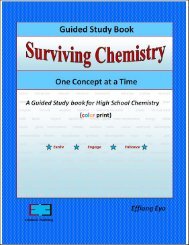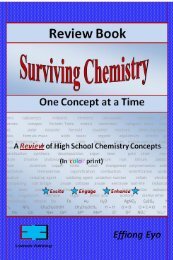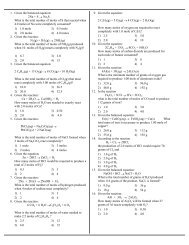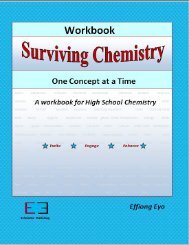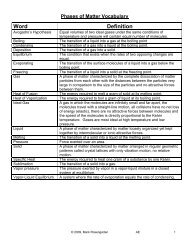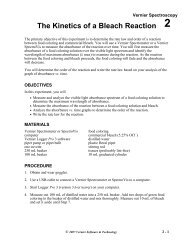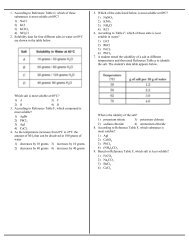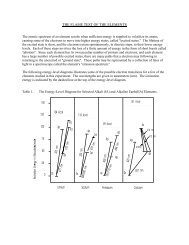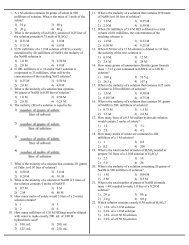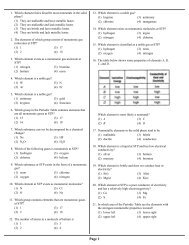Kinetics, Thermodynamics and Equilibrium - Revsworld
Kinetics, Thermodynamics and Equilibrium - Revsworld
Kinetics, Thermodynamics and Equilibrium - Revsworld
You also want an ePaper? Increase the reach of your titles
YUMPU automatically turns print PDFs into web optimized ePapers that Google loves.
5) Changing <strong>Equilibrium</strong> (HW: p. 32, 33)<br />
Objective: You will use Le Chatelier’s Principle to predict the direction an equilibrium will shift when a stress is<br />
applied to it, <strong>and</strong> predict the resulting change in concentration of reactants <strong>and</strong> products.<br />
<strong>Equilibrium</strong> systems are dynamic, meaning they are constantly in motion. <strong>Equilibrium</strong> must be in a closed system, or<br />
the system cannot remain at equilibrium. But sometimes you don’t want your system to be at equilibrium! How<br />
irritating it would be if you went to all the trouble to make a product, just to have it decompose back into the reactants<br />
again <strong>and</strong> reach equilibrium! How can you force a system at equilibrium to do what YOU want it to? That’s right!<br />
Make equilibrium work for YOU!!!<br />
Le Chatelier's Principle<br />
If a system at equilibrium is subjected to a stress (any factor that affects reaction rate, like temperature, concentration<br />
<strong>and</strong> pressure for gases), the equilibrium will shift in a way that relieves the stress, in the direction of whichever reaction<br />
was made faster by the stress. This will cause a change in concentration of both the reactants <strong>and</strong> products until the<br />
equilibrium is re-established.<br />
FORWARD SHIFT<br />
<br />
Reactants Products<br />
REVERSE SHIFT<br />
Stress Shift Change In Concentration<br />
Adding reactant<br />
This increases the number of collisions<br />
between reactant particles, making the Reactants: decrease<br />
FORWARD reaction go faster.<br />
Products: increase<br />
Removing reactant<br />
This decreases the number of collisions<br />
between reactant particles, making the Reactants: increase<br />
REVERSE reaction faster than the<br />
forward reaction.<br />
Products: decrease<br />
Adding product<br />
This increases the number of collisions<br />
between product particles, making the Reactants: increase<br />
REVERSE reaction go faster.<br />
Products: decrease<br />
Removing product<br />
This decreases the number of collisions<br />
between product particles, making the Reactants: decrease<br />
FORWARD reaction faster than the<br />
reverse reaction.<br />
Products: increase<br />
This depends on the direction of shift.<br />
Increasing Temperature This favors the ENDOTHERMIC<br />
reaction, causing the equilibrium to shift<br />
AWAY FROM THE SIDE WITH HEAT<br />
to absorb the excess energy,<br />
Decreasing Temperature This favors the EXOTHERMIC reaction,<br />
causing the equilibrium to shift<br />
TOWARDS FROM THE SIDE WITH<br />
Increasing Pressure<br />
(gases only)<br />
Decreasing Pressure<br />
(gases only)<br />
HEAT to release energy,<br />
This causes the system to bring the<br />
pressure back down by shifting<br />
TOWARDS THE SIDE WITH FEWER<br />
MOLES OF GAS on it.<br />
This causes the system to bring the<br />
pressure back UP by shifting<br />
TOWARDS THE SIDE WITH MORE<br />
MOLES OF GAS on it.<br />
IF THE SHIFT IS TOWARDS THE<br />
PRODUCTS, THEN PRODUCTS<br />
WILL INCREASE AND REACTANTS<br />
WILL DECREASE.<br />
IF THE SHIFT IS TOWARDS THE<br />
REACTANTS, THEN REACTANTS<br />
WILL INCREASE AND PRODUCTS<br />
WILL DECREASE.<br />
© 2009, Mark Rosengarten AE 20



